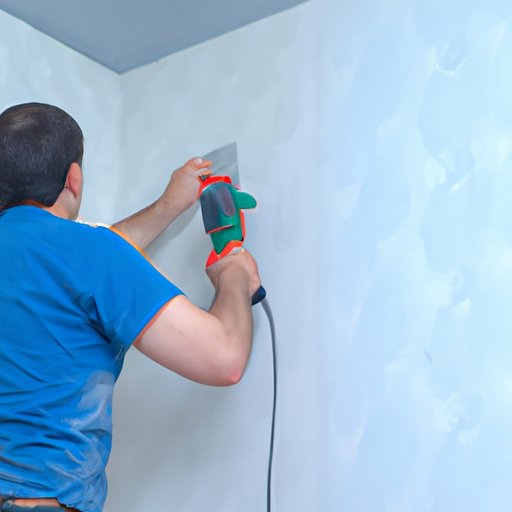
Introduction
Installing drywall is an important part of any home or building construction project. It covers the framing, insulation, and wiring, and provides a smooth surface for painting or wallpapering. However, the process of installing drywall can be intimidating for beginners. This article will provide a step-by-step guide, tips for beginners, tools and equipment needed, common mistakes to avoid, comparison of different types of drywall, and common drywall repairs to help you easily complete the task.
Step-by-Step Guide
The first step in installing drywall is to measure the walls or ceiling where the drywall will be placed. Once you have measured, you will need to cut the drywall to fit the dimensions of your measurements. For walls, measure the height and length of the wall. For ceilings, measure the width and length of the area. Using a drywall knife, cut the drywall to the required dimensions.
Once the drywall is cut, the next step is to hang it. Attach the drywall to the walls or ceiling, leaving a gap of about 1/8 inch between each sheet to allow for expansion. You can use screws or nails to attach the drywall. Nails are cheaper, but screws provide a tighter and more secure hold.
After the drywall is hung, the next step is to tape the seams. Apply joint tape over the seams and use a drywall knife to apply thin layers of joint compound over the tape. Repeat this process until the seams are smooth and level with the rest of the wall.
Lastly, sanding and finishing the drywall is necessary. Sand down any rough spots on the wall and apply a coat of primer. Once dry, you can paint or wallpaper the wall as desired.
Tips for Beginners
When installing drywall, it’s important to take measurements accurately, and to cut the drywall to fit your dimensions. Ensure that you have enough drywall materials for the project and invest in good quality tools such as drywall knife, screws/nails, and joint compound. Another helpful tip is to hang the drywall vertically instead of horizontally. This decreases the amount of butt joints which are more prone to cracking.
Tools and Equipment Needed
To install drywall, you will need a few tools and equipment. Drywall knife, keyhole saw, utility knife, cordless drill, sandpaper, safety goggles, measuring tape, T-square, drywall screws/nails, joint tape, and joint compound. Always put on your safety goggles when working to protect your eyes from dust and possible debris.
Common Mistakes and How to Avoid Them
The most common mistake that people make is not measuring accurately and cutting drywall improperly. This leads to gaps and deformities in the wall. Other common mistakes involve visible edges and seams or uneven walls after installation. To avoid these mistakes, it is important to measure accurately and use a good quality drywall knife to make clean cuts. Also, be careful when attaching the sheets to avoid any bumps or deformities. Repeat the application of joint compound evenly and let it dry completely before sanding for optimum smoothness.
Compare Different Types of Drywall
There are several types of drywall available on the market today that differ primarily in thickness, soundproofing abilities, fire resistance and moisture resistance. Regular / standard drywall is good for interior walls and ceilings that do not require special resistance. Soundproof drywall is effective for rooms that require less noise. Moisture, fire and mold-resistant drywall are used on wet areas and are resistant to water, fire, and mold. Choose the type that best suits the specific environment where the drywall will be used.
Common Drywall Repairs
Drywall is vulnerable to different types of repair issues. Holes from nails and screws, cracks on the seams and the wall surface, and water damage are the most common. For nail and screw holes, cover them up with joint compound or a drywall patch. Cracks in the wall surface and seams can be filled with joint compound and then sanded down. Water damage would require cutting away the damaged section and replacing with a new piece of drywall. To prevent drywall repairs, always make sure that there are no leaks in the area where the drywall is installed.
Conclusion
Installing drywall can sound daunting to beginners, but with the right tools, step-by-step guide, tips, and knowledge of what can be done to solve common problems, anyone can do it. Remember, always use the right safety precautions, proper measurements, and quality materials to ensure the successful installation of your drywall. If you have any questions or want to share your experiences, please leave a comment below.





